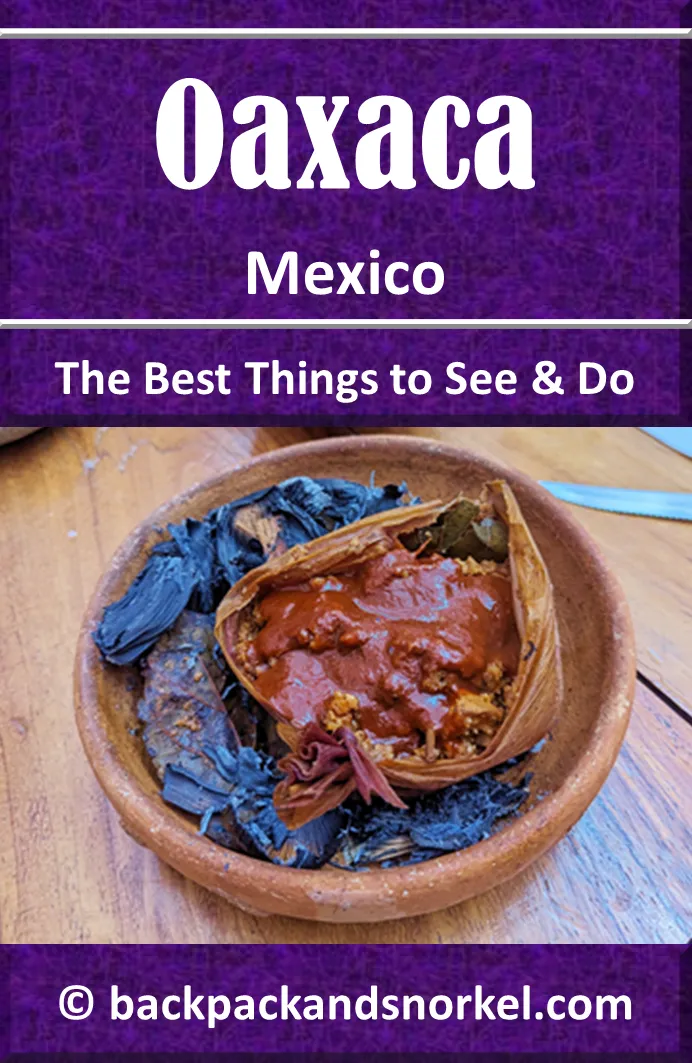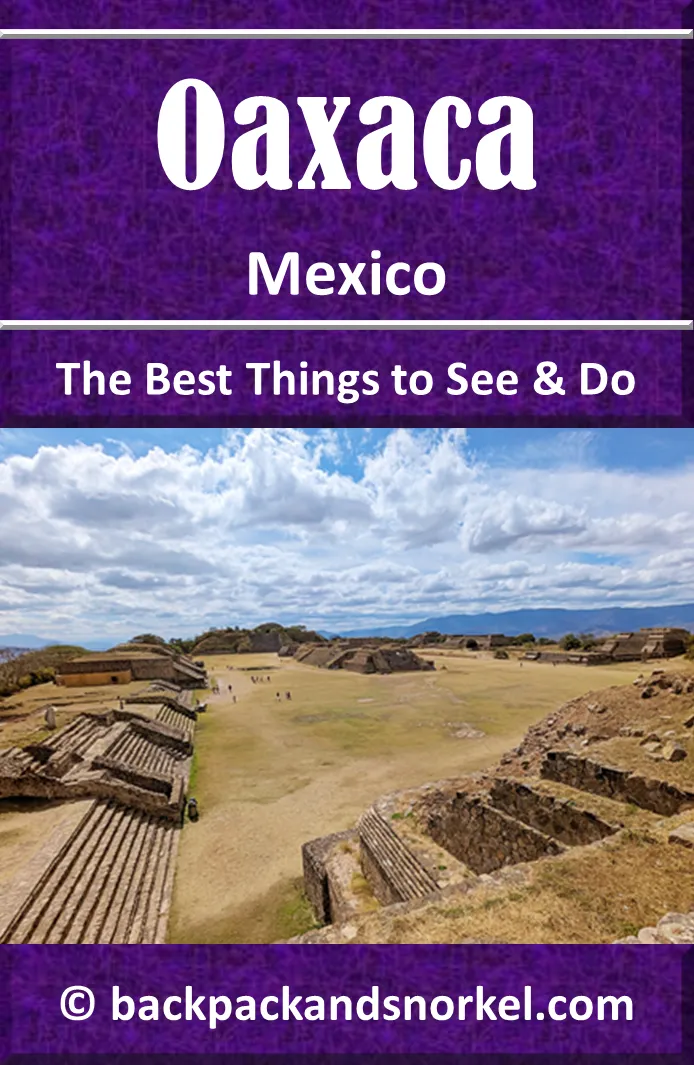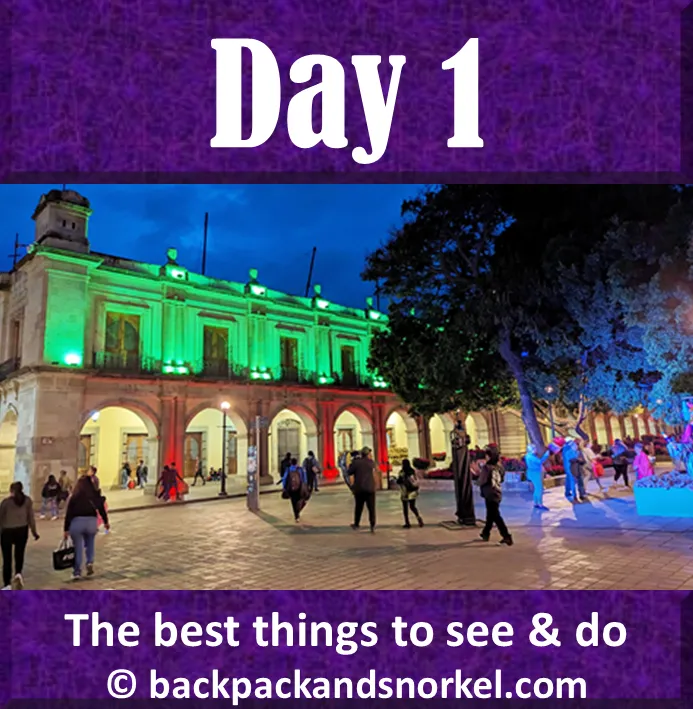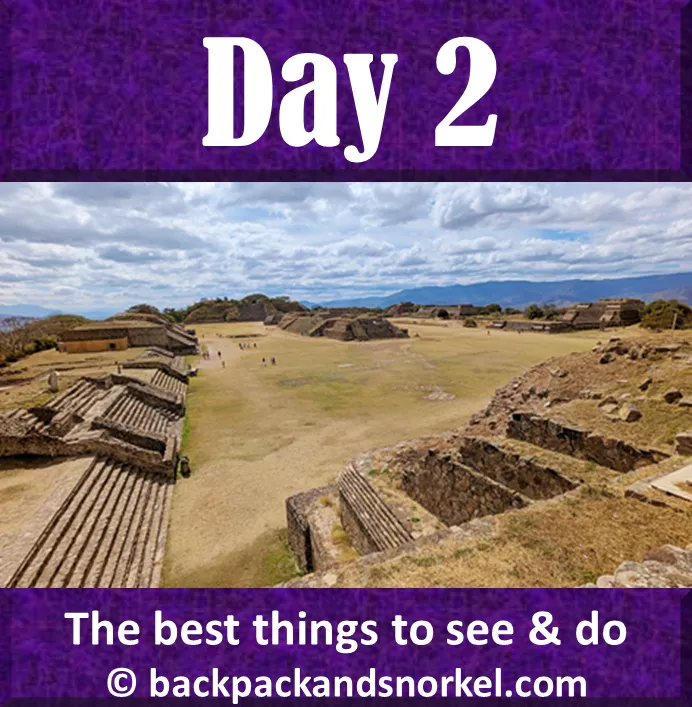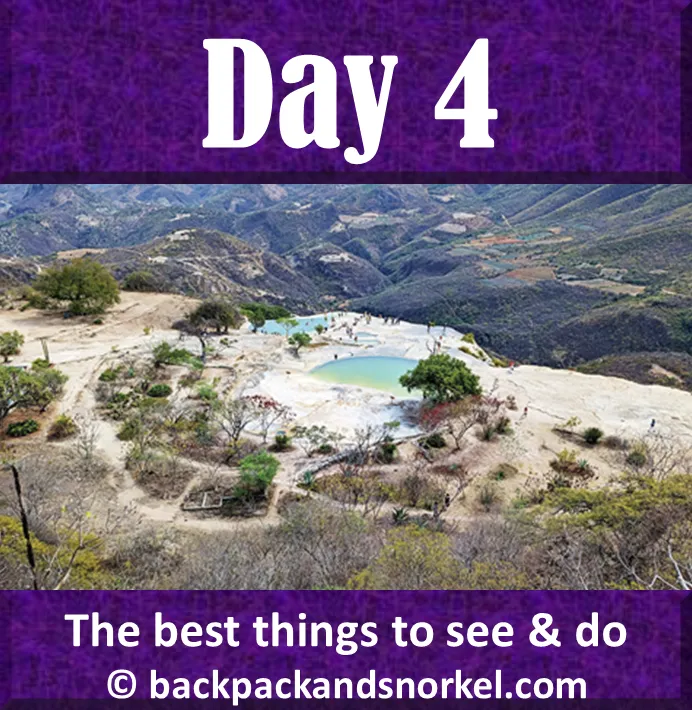Backpack and Snorkel Travel Guide for Oaxaca - Oaxaca Purple Travel Guide
Oaxaca is known for its stunning colonial architecture, rich indigenous culture, and heritage, and it is considered Mexico's culinary capital. We provide detailed information and the best things to see and we show lots of photos so you know what you can expect.
Oaxaca is one of the most popular non-beach vacation destinations for Mexicans and it has gained increasing popularity with US Americans, Canadians, and Europeans in the last years due to its vibrance and authenticity.

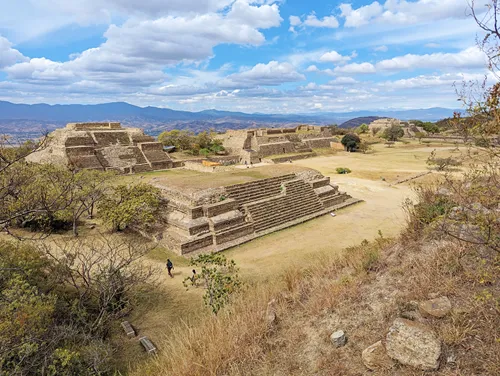
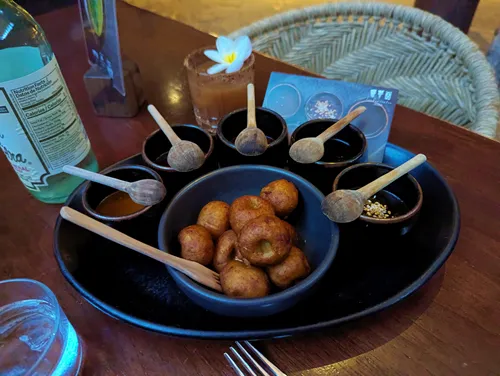
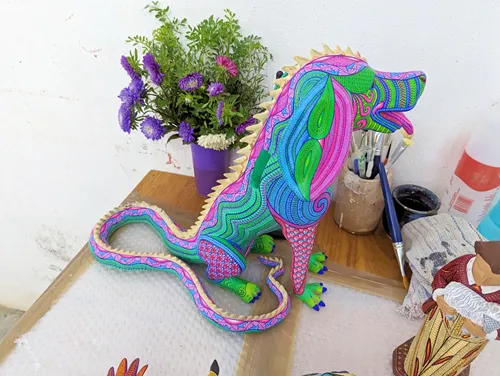
In this Oaxaca Purple Guide, we will tell you what you need to know to visit Oaxaca in five days and we provide you with tours that bring you to the historic, cultural, and culinary highlights of Oaxaca.
To help you find out what best fits you, we have added lots of photos and links to google maps locations and additional reviews.
Join us to explore the best things to see and do in Oaxaca in nine days.
This is not an in-depth Oaxaca guide – and you will need a lot more than five days to see all the highlights of Oaxaca. You can buy in-depth Oaxaca guides from the big travel guide companies. Our goal is to help you Make Memorable Moments on a relaxing Oaxaca trip and help you build the perfect itinerary for your trip. For that purpose, we have added lots of photos so that you see what you will experience and make an educated decision if these places are for you.
Please also check out the other exciting destinations and travel guides on our Backpack and Snorkel website.
General Information about Oaxaca |
Itinerary for a 5-day trip of Oaxaca |
Five-day Itinerary for Oaxaca |
General Information about Oaxaca
Oaxaca is pronounced equally in two ways: oa-hah-ka or wah-hah-ka. The stress is on HAH. If you use the OA pronunciation, both letters in OA are pronounced.
Oaxaca, also called Oaxaca de Juárez or Oaxaca City, is the capital and largest city of the Mexican state of Oaxaca.
The city and the nearby archeological site of Monte Albán were designated a UNESCO World Heritage Site in 1987.
Today, heritage tourism of the local Zapotec and Mixtec cultures and structures, fascinating colonial buildings and Oaxaca’s culinary scene are the most important drivers of the local economy and account for almost 80% of all jobs.
The Oaxaca Valley was inhabited by the Zapotecs since approx. 2,500BC and later partially succeeded by the Mixtec starting around 900AD. Important settlements during those times were Monte Albán and Mitla.
Starting in 1440, the Aztecs entered the valley and named it Huaxyacac, which means: among the huaje trees. Huaje trees are a small, fast-growing type of native tree.
In 1521, the area was conquered by the Spanish in hope of finding the Aztecs' gold that Moctezuma II had told them came from here.
In 1522, construction of the first cathedral was begun and the settlement was called Guajaca. The name Guajaca was chosen as a more Spanish sounding variation of Huaxyacac.
From the beginning, Oaxaca was a fairly independent own, much to the disliking of Spanish conquistador Cortes. Cortes sent his army several times to drive the population out of Oaxaca and replace the government with his puppets. Every time, the Spanish settlers appealed to the Spanish crown and got their city and independence back.
The final win for the settlers was in 1532, when the Spanish crown granted the settlement the status of a city under the direct control of the king, rather than of Cortes. The city name was changed to Nueva Antequera.
After the Independence of Mexico in 1821, the city was renamed to Oaxaca and in 1872, the city name was changed to: Oaxaca de Juárez. This was done to honor Benito Juárez, a Zapotec man from Oaxaca, who was the first indigenous president of Mexico and who served as President from 1858 until his death in 1872.
Culinary Highlights of Oaxaca
Oaxaca is considered to be the culinary capital of Mexico. Some of the most popular dishes are:
- One of the staple foods of Oaxaca are moles, in fact, Oaxaca is called the land of the seven moles. Moles are made with a variety of ingredients such as chilies, nuts, spices, and chocolate and sometimes require thirty ingredients. Moles can be found at any Oaxacan restaurant, but most only serve black and red moles. Our proposal is to try the mole sampler at Los Danzantes which has five different moles.
- Another staple food of Oaxacan cuisine are Tlayudas. Tlayudas are large crispy tortillas covered with refried beans and quesillo and various toppings, and are sometimes called Oaxacan pizzas or Mexican pizzas. Good places to get them are Tlayudas La Chinita (after 8pm) and Mercado 20 de Noviembre.
- Fried chapulines (grasshoppers) can be bought in every mercado and many restaurants offer them as a side dish.
- Cacao is popular in Oaxaca. People typically drink it as Tejate, which is made by hand-mixing a paste of toasted maize, fermented cacao beans, toasted mamey pits, and flor de cacao with water.
- Mezcal: Mezcal is made from similar ingredients as Tequila, but uses a different process and is only produced by manual labor, while the Tequila process is typically fully automated. Like Tequila, Mezcal is either unaged or aged for various times to give it a smoother texture and darker color. In Oaxaca, every restaurant seems to have Mezcal and if you drive around in Oaxaca state, you will see artisan Mezcal producers every few miles. Try it and see if you like it.
- Quesillo: Quesillo is a type of semi-soft stringy cheese that is only manufactured by hand. It seems that almost every cheese-containing dish in Oaxaca has quesillo in it. The center of quesillo manufacturing is in Villa de Etla and we recommend visiting one of the few quesillo producers that allow you to see their process with a tour guide.







Should you not like Mezcal, then try one of the many crema flavors. We especially liked the green pistachio crema.

Some Mezcal manufacturers offer white chinicuiles or red maguey worms to eat. Those are caterpillars who live inside agave plants. They are sometimes also added to the Mezcal for additional flavor.

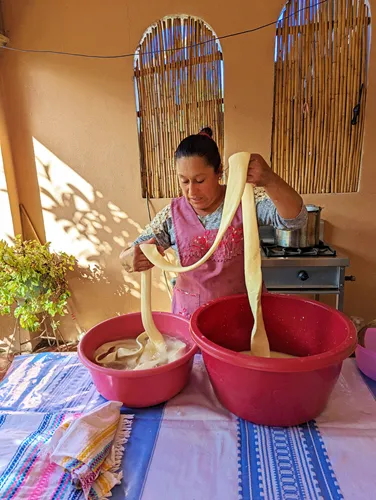
Getting around in Oaxaca
Most of Oaxaca’s attractions are located within a small easily walkable area in historic downtown.
Other attractions like Monte Alban, Mitla, Hierve el Agua and El Tule and the artisan towns can either be reached by taxi, or better by rental car or with a tour guide.
Downtown Oaxaca is a maze of one-way streets (which are not always obvious), speed bumps and lots of pedestrian and motor vehicle traffic. Parking is only available in inexpensive paid parking lots. Often, roads are closed for construction or events and no detours are posted, so our advice is to stay close to the historic center.
If you come from the airport, take a taxi or a transfer service to your hotel, or get a rental car. You can book rental cars in Oaxaca here.
Where to stay in Oaxaca
Oaxaca’s historic center is very walkable and driving a car can be exhausting, because of all the one-way streets, road closures, traffic, and limited parking. We therefore recommend staying near the Zocalo in the historic center of Oaxaca.
The map below shows which hotels and Airbnbs are available:
Hotel Trébol (map, reviews, booking)
Located in the heart of historic downtown Oaxaca, across a pedestrian street from Mercado Benito Juárez and one block away from the Zócalo (Plaza de la Constitución), this hotel has one of the best locations for your stay in Oaxaca. The main entrance is located on the corner of a city block with one road being busy with car and motorcycle traffic and the other road being a pedestrian-only street. As this is a very centrally located hotel, there is always traffic, lots of people and some noise. However, once you get into the building, things calm down significantly.
The hotel has free parking in a parging garage a few blocks away. When you first get to the hotel, you will need to stop in the small space adjacent to the entrance, go to the hotel reception and ask the bell boy at the front desk to get into your car and guide you to the garage. At the garage, the bell boy will open the gates and let you in. After getting your belongings, he/she will walk you back to the hotel – this is a 0.2-mile (350 m) walk. This is the same procedure every time you need to access the garage, as the hotel will not give the garage door opener to its guests. Please do not forget to tip the bell boy!
The hotel itself is a beautifully built 3-story hacienda-style hotel. Breakfast is served and you get to choose one of three dishes.
We had a room facing an interior courtyard and did not hear any traffic noise.
Our room had a quiet and efficient air-conditioning wall unit, a TV which we did not use and fast and reliable wifi. Two free bottles of water and toiletries were provided daily.
The hotel would get five stars if there would not have been one issue, which many travelers seem to complain about: The shower seems to only have water that is either too hot or too cold. Officially, the hotel says that they heat water by solar and provide a bucket to collect the cold water that will come out of the lines for the first minute or so. Unfortunately, when you turn on the hot water, it soon turns too hot, regardless of your settings, and if it gets too cold if turn the hot water down. We were able to shower by using the water during the transition from too hot to too cold and vice versa. One time, there was no cold water for a few minutes and another time there was not hot water for a few minutes.
We consider this to be only a small inconvenience, considering that the hotel is competitively priced, in the heart of the city and everything else is close to perfect.




Climate of Oaxaca
Oaxaca has a tropical savanna climate with daily high temperatures typically above 80 F (27 C). Due to Oaxaca’s high elevation, nighttime temperatures can go as low as 48 F (9 C).
The rainy season runs from May through September with April and October as transition months.
Here is the climate that you can expect when you visit Oaxaca:


The best time to visit Oaxaca
For tourists, the best time to visit Oaxaca is the high season from November through April. The weather is at its best and there are many festivals and cultural events celebrated in the city, including Dia de Muertos (Day of the Dead).
During high season, two periods are extra busy:
- Holy week: from Palm Sunday (the Sunday before Easter) until Easter, many Mexicans travel to visit family and relatives in Oaxaca
- Christmas to New Year: many Mexicans travel to Oaxaca to visit relatives and family
The summer months can be rainy, hot, and humid. As there are fewer tourists, hotel rates are generally lower, except for Guelaguetza, which is also called Los Lunes Del Cerro (Mondays on the hill).
Guelaguetza is an important annual indigenous cultural event in the city of Oaxaca and nearby villages. It takes place on the two Mondays after July 16, except when the first Monday falls on July 18 which is the day on which Benito Juárez died in 1872.
Money, ATMs, and Credit Cards in Oaxaca
The only currency accepted in Oaxaca is the Mexican Peso. You can find the exchange rate here.
You can pay almost everything by credit card (Visa and MasterCard), except for street vendors and many parking garages, who only accept cash.
There are plenty of ATM machines to get cash. Before you use any ATM in Mexico, take a close look at the card slot to ensure that there is no skimming device that will steal your card number and PIN.
Tap water in Oaxaca
Tap water in the state of Oaxaca is never safe to drink. Many hotels and some Airbnb’s provide or bottled water of filtered water which is apparently safe to drink. I do not understand how normal filters will combat bacterial contamination and that is why we always boil our drinking water.
Ice in hotels and restaurants that cater to tourists is normally made from purified water and should therefore be safe to drink. Be careful with small local restaurants or street vendors, as they may use regular tap water to make their ice.
Time zone of Oaxaca
Oaxaca is located in the same time zone as Houston in the USA; Oaxaca observes daylight savings time. You can see the local time here.
Telephone
The international calling code for Mexico is: +52
The area code of Oaxaca City is: 951
For international calls. Use: +52-951
Itinerary for a 5-day trip of Oaxaca
This 5-day itinerary covers many of the major highlights of Oaxaca. If you have more time then you can add more artisan villages near Oaxaca. In case you have less time, please read through this Purple Travel Guide, and take the things out that you are not interested in.
Here is the suggested itinerary:
Day |
Activities |
Day 1 |
Arrive in Oaxaca; Mercado Benito Juárez; Zócalo; Catedral Metropolitana de Oaxaca; Calle Macedonio Alcalá; Templo de Santo Domingo de Guzmán; Museo de las Culturas de Oaxaca; dinner at Levadura de Olla Restaurante |
Day 2 |
Monte Albán; Basílica de Nuestra Señora de la Soledad; dinner at Los Danzantes |
Day 3 |
Zona Arqueologica de Mitla; Santa María del Tule (Letras Turisticas ’El Tule’; Árbol del Tule; Templo de Santa María de la Asunción; Mercado Gastronómico de Santa María del Tule); dinner at Mercado 20 de Noviembre or Tlayudas La Chinita (after 8pm) |
Day 4 |
Guided tour: Hierve el Agua with Mezcal distillery |
Day 5 |
Guided tour: Oaxacan Cheese Experience in Reyes Etla; fabric production and dyeing in Teotitlán del Valle; Alebrijes tour in San Martín Tilcajete; shiny black pottery in San Bartolo Coyotepec |
Day 6 |
Depart Oaxaca |
Where do you want to go now?
Author: Rudy at Backpack and Snorkel
Bio: Owner of Backpack and Snorkel Travel Guides. We create in-depth guides to help you plan unforgettable vacations around the world.
Other popular Purple Travel Guides you may be interested in:
Like this Backpack and Snorkel Purple Travel Guide? Pin these for later:
